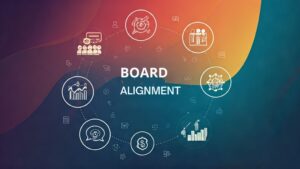
Key Highlights
- It is important to align your board’s vision with your strategic plan for good decision-making in your nonprofit.
- If they do not align, confusion can happen, and you may waste resources and miss chances.
- Clear communication and teamwork are key to achieving alignment.
- Check how well your board understands and supports the strategic goals often.
- Use tools such as checklists and case studies to help keep everyone aligned.
Introduction
In nonprofit organizations, strategic planning helps guide all choices and actions. It is just as important for every board member to share this vision. Having the board aligned is key for making good decisions and reaching goals. This article will discuss why it matters for your board to match your strategic plan, the risks of not being aligned, and useful ways to create a strong and effective board.
Understanding the Importance of Board Alignment

Imagine a rowing team where each person is paddling at their own speed and in their own way. This would cause chaos and make it hard to move forward. A nonprofit board works the same way. If board members do not share a common understanding of the strategic direction, their efforts may clash. This can lead to confusion and weaken the organization.
However, when a board is truly united around a shared strategic direction, they become a strong team. They can make smart decisions, support the mission better, and guide the organization towards a successful future. Working together makes all the difference in creating a positive impact.
The Impact of Strategic Alignment on Decision Making
When your board understands and accepts the strategic direction, good things happen throughout the organization. Decision-making in board meetings gets easier and faster. This is because every member uses the same information and shares the same goals for the organization.
Here’s how this alignment helps board decision-making:
- Informed Decisions: Board members can take part in discussions and share insights based on a common understanding of the strategic plan.
- Reduced Conflict: When everyone shares the same vision, there are fewer disagreements. It’s simpler to agree on what to do next.
- Strategic Focus: Meetings concentrate on the goals of the strategic plan, preventing distractions from less important issues.
This creates a team atmosphere where everyone works together and cares about success.
Why Misalignment Between Board and Strategy Is Costly
Misalignment can be a big problem for nonprofits. When the board does not understand the organization’s strategic planning, it can lead to distrust and frustration. This can also affect the chief executive and staff. Many resources, time, and energy can be wasted on projects that do not support the strategic goals.
Also, when there is misalignment, it can make it hard for the organization to change with the environment. This can limit the ability to grab new opportunities or face challenges. In the end, this can keep the nonprofit from fulfilling its mission and helping those in need.
By understanding the risks of misalignment, nonprofits can work to fix the problem early. They can build a better relationship between the board and the strategic planning process. This way, everyone can work together more effectively toward their goals.
Identifying Misalignment: Signs and Symptoms
Noticing issues early is very important for getting things back on track. If your board meetings often clutter with arguments about what to focus on, it might be a sign. Also, if choices feel disconnected from your clear goals, that’s another signal for concern.
These issues show that it might be time to take a close look at your board’s direction. By spotting these signs, you can make the necessary changes to keep everyone working together as a team.
Common Challenges Faced by Nonprofit Boards
Nonprofit boards face many challenges in a complex world. One big issue is the unclear boundaries between the board’s role and the staff’s role. It’s important for board members to know their focus should be on guiding the organization, not getting involved in day-to-day tasks. This way, they can keep their attention on strategic oversight.
Another challenge comes from the ever-changing environment around nonprofits. New chances, surprises, and shifts in funding can test an organization’s ability to adapt. If board members don’t understand the strategic goals, they may resist change. This resistance can hurt the organization’s chances of success.
To keep things running smoothly, it’s key to recognize and tackle these issues before they become major problems. A well-aligned board helps guide the organization in tough times, allowing it to grow and succeed.
Assessing Your Board’s Current Alignment with Strategic Goals
Evaluating how well your board aligns with your strategic plan is key to making improvements. Start by having open chats with your board members. Talk about their understanding of the strategic planning document and what part they play in achieving its goals.
Encourage them to share their thoughts. Listen carefully to their concerns and ideas. This honest exchange can reveal any misunderstandings or hidden issues. It can also show where the board needs more help or clarity.
Keep in mind that making sure everyone is on the same page is a continuous journey, not just a one-time task. By regularly checking for gaps in understanding or commitment, you can help your board stay strong and effective in guiding your organization to success.
Strategies for Enhancing Board Alignment

Strengthening board alignment means building a culture where everyone shares understanding and communicates openly. It helps to give board members the right knowledge and tools. They can then support the organization’s purpose more effectively.
You can create strong teamwork by using simple strategies. It’s important to make sure everyone on the board feels heard and appreciated. When board members work together well, it can move your organization toward a brighter future.
Best Practices for Communicating Strategic Plans to Your Board
Communicating the strategic plan well is very important for getting the board on the same page. Instead of giving board members complicated documents, use clear and fun presentations. This will help everyone understand and remember the strategy better. Including the strategic plan in your board meeting agenda helps make it an important part of every discussion.
Consider these best practices:
- Engaging Presentations: Use visuals, stories, and real-life examples to make the strategic plan easier to understand for board members.
- Dedicated Discussion Time: Set aside enough time in the board meeting agenda for detailed talks and Q&A about the strategic plan. This lets members ask questions and fully understand the direction we’re going.
- Regular Updates: Share regular progress reports with the board. Talk about both successes and challenges to remind them of the plan’s importance and their role in it. The CEO should take part in these updates to keep the lines of communication open.
By treating the strategic plan as a living document, you help the board connect with it more often. This builds a better understanding and stronger commitment to the plan.
Incorporating Behavioral Principles for Better Board Engagement
Understanding how people make decisions and engage can really help improve alignment on the board. You can use simple behavioral principles like framing, social proof, and commitment bias. By framing discussions in a positive way, you can show how the board’s choices affect the organization’s mission.
It’s important to recognize and celebrate small wins. Highlight how each board member’s work helps reach the bigger strategic goals. This kind of positive feedback can lift spirits and strengthen their commitment to the plan.
Getting board members involved in specific parts of the strategic plan can make them feel more ownership and responsibility. This approach boosts both their engagement and alignment with the strategic direction.
Actionable Steps Towards Alignment
Moving from understanding to action means you need to take clear steps. Start by making simple tools that show what is expected. Sharing real-life examples helps your board members connect better with these ideas.
Keep in mind that board alignment is a journey, not a one-time goal. By making these steps and promoting a culture of learning, your group can handle challenges well. This way, you can reach lasting success together.
Developing a Checklist for Board-Strategy Alignment
(Instructions: 100-150 words, 3 paragraphs including a text table, NLP terms: checklist, strategic direction, board member, Tone: Empathetic, supportive)
A practical tool for ensuring ongoing alignment is a checklist that board members can use as a reference point. This checklist can be integrated into board meeting materials or used as a self-assessment tool for individual board members to evaluate their understanding and alignment with the strategic direction.
Here’s a simple framework:
| Checklist Item | Yes | No | Needs Improvement |
|---|---|---|---|
| I can clearly articulate our mission. | |||
| I understand the organization’s strategic goals. | |||
| I know my role in achieving these goals. |
This table serves as a starting point. You can customize it with specific objectives, metrics, and key performance indicators (KPIs) relevant to your organization’s strategic plan.
Case Studies: Successful Alignment in Action
Learning from the success of others can be very helpful. Sharing case studies from other nonprofits that have reached good board alignment can give your organization useful ideas. These case studies can show the problems faced, the actions taken, and the good results that came from a united board.
Think about inviting leaders from these successful groups. They can share their experiences and best practices with your board. You could do this through presentations or informal Q&A sessions. Seeing real examples makes the idea of board alignment clearer. It also gives your organization a guide to follow for success.
By showing the good effects of alignment, you can encourage your board members. This can help them be more open to joining the process. A more united board can lead to a stronger and more effective organization.
Conclusion
In conclusion, board alignment is very important for good decision-making in all organizations, especially nonprofits. When everyone is on the same page, it helps the group work towards shared goals and avoids expensive mistakes. By using best practices for communication and involvement, boards can improve their alignment and boost success. Creating a checklist that fits your organization’s needs and learning from examples of success can help you stay on track. Regular check-ins and honest talks are very important to keep this alignment strong over time. Remember, a united board can greatly improve fundraising and the success of the whole organization. Use these strategies to build a strong and positive board environment.
Frequently Asked Questions
How often should we review our board’s alignment with our strategic plan?
It’s a good idea to check your board’s alignment once a year. Try to include this in a special board meeting. You can also use templates or checklists during the year to see how well you are aligned.
What are the first steps in addressing board misalignment?
Recognizing the problem is important. Start by talking openly with your board. Make sure to clarify the strategic direction. It’s also vital to confirm the role of the board compared to the CEO and the staff. This will help avoid any misalignment and confusion.
Can a misaligned board affect fundraising efforts?
Funders want to see a clear strategy and strong teamwork. When board members are not aligned, it can hurt fundraising efforts. This can lead to doubt and negatively affect decision-making. Keeping the board united is important for success.
How can we involve the board in strategic planning effectively?
Involve board members at the start of the strategic planning process. Ask for their thoughts on the board meeting agenda. Use their knowledge well, and make sure that the chief executive appreciates their help to keep everything aligned.
What tools can help maintain alignment over time?
Regular communication and using visual dashboards can help track progress toward strategic goals. Setting aside time in board meetings is important too. Resources from organizations like BoardSource can be very helpful in maintaining alignment during this process.

